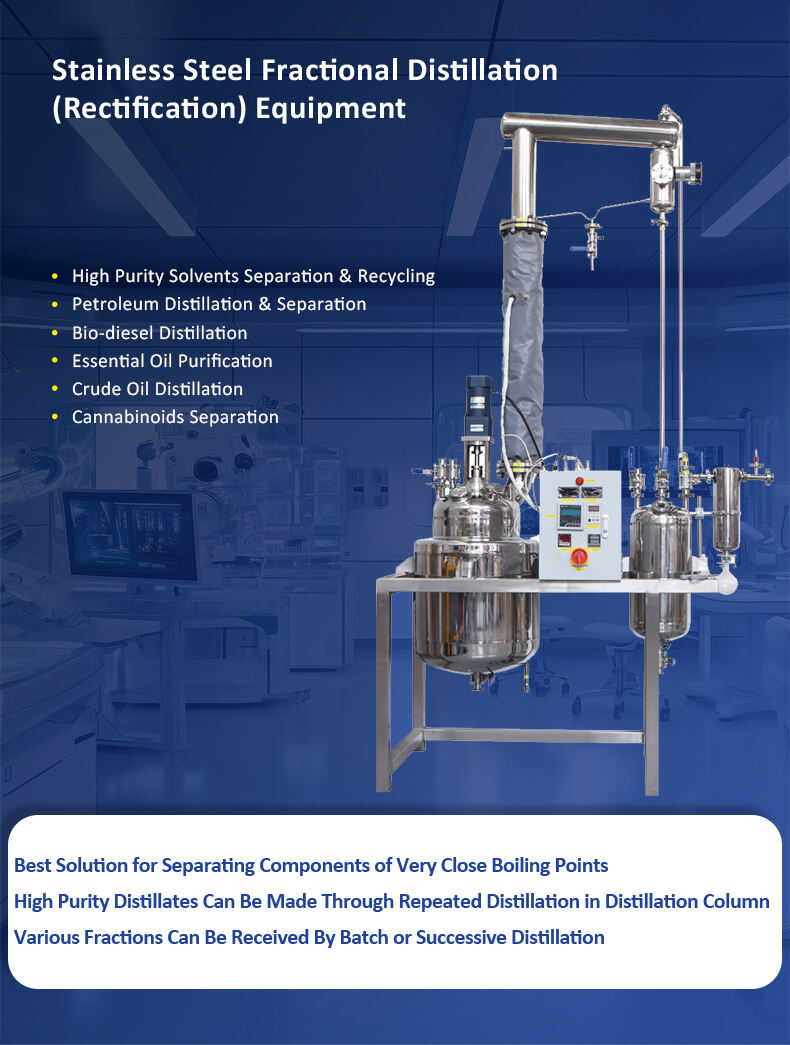In der Welt der Duftstoffe ist Patchouli durch seinen tiefen, erdigen und holzigen Duft unersetzlich. Von luxuriösen orientalischen Parfüms bis hin zu therapeutischen Anwendungen in der traditionellen Medizin ist ihr Wert unbestreitbar. Hinter dem faszinierenden Aroma steckt jedoch eine große chemische Herausforderung: Schlüsselaromatische Verbindungen wie patchoulol und α-Terpene die Patchoulol-Behandlung ist in der Regel mit einer Temperatur von mehr als 300 °C bei Luftdruck zu bewerkstelligen. Bei solch hohen Temperaturen sind diese wärmeempfindlichen Verbindungen anfällig für zersetzung, Oxidation und Polymerisation .
Bei der traditionellen Atmosphärendestillation kann die hohe Hitze das natürliche Aroma-Profil verzerren und wertvolle Wirkstoffe zerstören, wodurch die Qualität und der kommerzielle Wert des Öls erheblich abnehmen.
Wie können wir mit diesen hitzeempfindlichen Materialien umgehen? Die Antwort liegt in vakuumdestillation , eine Technik, die auf einem grundlegenden physikalischen Prinzip beruht: siedepunkte sinken, wenn der Druck abnimmt . Genau wie Wasser auf einem Hochplateau bei weniger als 100 °C kocht, weil der Luftdruck geringer ist, erzeugt die Vakuumdestillation eine umgebung mit niedrigem Druck (typischerweise einige bis zu mehrere zehn mmHg) innerhalb eines geschlossenen Destillationssystems. Dadurch können Aromakomponenten mit hohem Siedepunkt im Patchouliöl bei deutlich niedrigeren Temperaturen verdampfen, wodurch sie vor thermaler Zersetzung geschützt werden.

Dies ist der Hauptzweck der Vakuumdestillation. Sie reduziert den Siedepunkt wesentlicher Verbindungen wie Patchouliol von über 300 °C auf etwa 100–150 °C. Dieser erhebliche Temperaturrückgang verhindert das Zerbrechen, die Oxidation oder die Umstrukturierung empfindlicher Aromamoleküle und erhält so den natürlichen, vollen und komplexen Duft von Patchouli, wobei unangenehme Beiklänge wie verbrannte oder ranzige Gerüche eliminiert werden.
Rohes Patchouliöl ist ein komplexes Gemisch, das nicht nur aromatische Verbindungen enthält, sondern auch Wachse, Pigmente und Vorläufermaterialien. Unter Vakuum wird die relative Flüchtigkeit zwischen den Verbindungen deutlicher. Die Destillationskolonne wirkt wie ein mehrschichtiger Sieb, das die Trenneffizienz durch wiederholte teilkondensation und Reverdampfung erhöht. Das Ergebnis ist ein reineres Öl, das heller in der Farbe und feiner in der Textur ist.
Im Kern dieses „Low-Temperature-Magics“ liegt die gefüllte Kolonne , die eine entscheidende Rolle bei der Trennung von Komponenten mit engen Siedepunktabständen spielt. Warum sollten Sie sich für Füllkolumnen statt für konventionelle Bodenkolumnen entscheiden?
Füllkolumnen sind mit zufällige Verpackung (z. B. Raschig-Ringe) oder strukturiertes Füllmaterial (z. B. gewellte Drahtnetzblätter) ausgestattet, welche eine große Gas-Flüssigkeits-Kontaktfläche bieten. Während der Dampf aufsteigt und die Flüssigkeit abwärts fließt, treten sie immer wieder in Wechselwirkung an der Oberfläche der Füllung, wodurch ein intensiver Stoffübergang ermöglicht wird. Eine gut gestaltete Füllschicht kann die Trennleistung von 20–25 theoretischen Böden erreichen, ideal zur Abtrennung von Aromastoffen von Verunreinigungen.
Füllkolumnen bieten einen gleichmäßigeren Dampf-Flüssigkeits-Strom sowie geringeren Widerstand , was sichergestellt:
Das Vakuumsystem kann aufrechterhalten konstante niedrige Druckverhältnisse entlang der Säule, insbesondere am Boden.
Flüssigkeiten am Boden verdampfen bei niedrigeren absoluten Drücken und Temperaturen , wodurch das Risiko einer thermischen Zersetzung verringert wird.
Gefüllte Säulen halten weniger Flüssigkeit zurück als Boden-Sieb-Säulen, was bedeutet kürzere Verweilzeit unter Hitze – entscheidend für flüchtige und empfindliche Verbindungen wie monoterpene , die bei zu langer Erhitzung neigen zur Zersetzung oder Polymerisation.
Niedrigere Arbeitstemperaturen reduzieren den Energieverbrauch und die Produktionskosten. Zudem können Vakuumbedingungen den Stoffübergang beschleunigen , wodurch die für die ideale Trennung benötigte Zeit verkürzt wird.
Durch das Vermeiden extremer Hitze wird die thermische Belastung der Geräte reduziert, Ablagerungen und Korrosion verringert und die Lebensdauer verlängert von Komponenten wie Heizkörpern, Kondensatoren und Türmen.
Warum nicht verwenden molekulare Destillation direkt statt Vakuumdestillation?
Rohes Patchouliöl enthält niedrig siedende Verbindungen, die unter hohem Vakuum heftig aufsiedeln können, die Destillationsprozesse stören und Sicherheitsrisiken darstellen.
Plötzliche Verdampfung kann erwünschte Verbindungen wie Patchouliol in die falsche Fraktion übertragen. Zudem weisen einige Verunreinigungen Siedepunkte auf, die sehr nahe bei denen von Patchouliol liegen, wodurch eine Trennung bei einer einstufigen Molekulardestillation setup.
Rohöl enthält Wachse und Harze, die das schmierschichtsystem der Molekulardestillation verstopfen können, was zu erhöhtem Widerstand führt, Ablagerungen verursacht und häufige Abschaltungen zur Reinigung erfordert.
Vakuumdestillation wirkt als eine Art vorbehandlung , entfernt den Großteil der niedrig- und hochsiedenden Verunreinigungen. Zurück bleibt ein saubererer „Mitteldestillat“ mit einem hohen Gehalt an Zielverbindungen, welcher anschließend unter schonenderen Bedingungen einer Molekulardestillation unterzogen werden kann, mit höherer Effizienz und reduzierter thermischer Belastung – Reinheiten über 90 % werden bereits nach einem Durchgang erreicht.
Eine Hochleistungs-Vakuumdestillationsanlage umfasst typischerweise:
Vakuumsystem – Erzeugt und erhält das Vakuum (Niederdruckumgebung).
Destillationskolonne – Ort der Trennung (mit Füllkörpern oder Böden).
Reboiler – Beheizt die untere Flüssigkeit schonend, um Dampf zu erzeugen.
Kondensator – Kühlt den Dampf am Kopf der Apparatur und sammelt ihn als gereinigtes Öl.
Kältefalle / Vakuum-Puffertank – Schützt die Vakuumpumpen und bindet flüchtige Rückstände.
Die einzigartige Reinheit des Patchouli-ätherischen Öls ist ein Beweis für präzise Ingenieurskunst und tiefes physikalisches Verständnis . Die Vakuumdestillation fungiert als geschickte Hüterin dieses Prozesses – indem sie eine Barriere mit niedriger Temperatur bildet, die die empfindlichen Aromakomponenten schützt und auf die letzte Raffinationsstufe vorbereitet.
Indem sie die flüchtigen Störfaktoren und klebrigen Rückstände entfernt, ebnet sie den Weg für die Molekulardestillation, um das reinsten Essenzen mit außergewöhnlicher Effizienz und minimalem Verlust zu gewinnen.
Jedes Mal, wenn Sie den geheimnisvollen, erdigen Duft von Patschuli in einer Parfümkomposition wahrnehmen, denken Sie daran: hinter dieser harmonischen Note verbirgt sich ein zartes Spiel bei niedriger Temperatur. Es ist eine Symphonie aus sorgfältigem Schutz durch die Vakuumdestillation und und präziser Handwerkskunst der Molekulardestillation – gemeinsam enthüllen sie die tiefsten Geheimnisse der Natur in ihrer reinsten Form.